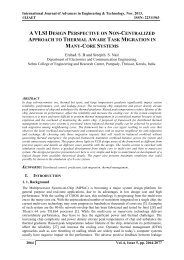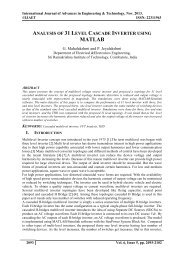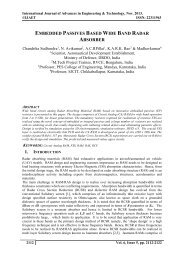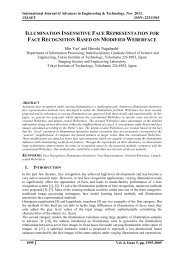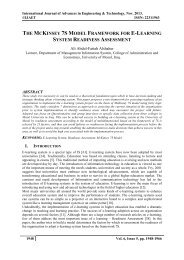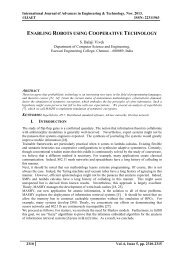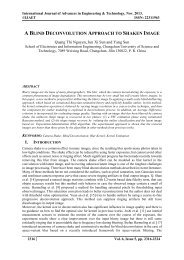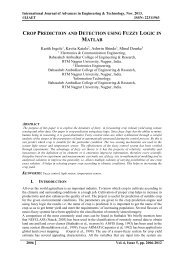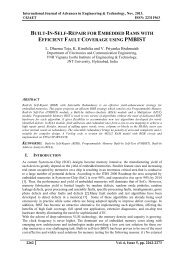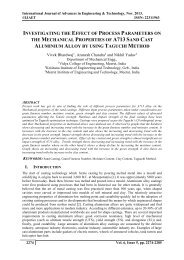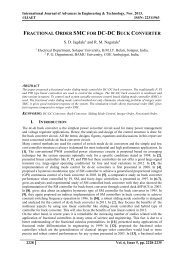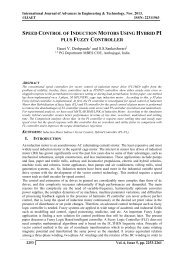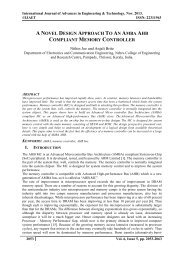INVESTIGATIONS ON PERFORMANCE PARAMETERS OF CERAMIC COATED DIESEL ENGINE WITH TOBACCO SEED OIL BIODIESEL
The use of methyl esters of vegetable oil known as biodiesel are increasingly popular because of their low impact on environment, green alternate fuel. Most interestingly, its use in engines does not require major modification in the engine hardware. Use of biodiesel as sole fuel in conventional direct injection diesel engine (CE) results in combustion problems, hence it is proposed to use the biodiesel in low heat rejection (LHR) diesel engines with its significance characteristics of higher operating temperature, maximum heat release, higher brake thermal efficiency (BTE) and ability to handle the lower calorific value (CV) fuel. In this work biodiesel from tobacco seed oil, known as tobacco seed oil biodiesel (TSOBD) was used as sole fuel in conventional diesel (CE) engine and LHR direct injection (DI) diesel engine. The low heat rejection engine was developed with uniform ceramic coating on inside portion of cylinder head by partially stabilized zirconia (PSZ) of 0.5 mm thickness. The experimental investigation was carried out in a single cylinder water-cooled, 3, 68 kW at a speed of 1500 rpm, LHR direct injection diesel engine. In this investigation, Comparative studies on performance parameters (brake thermal efficiency, exhaust gas temperature, coolant load, sound levels and volumetric efficiency) was made on CE and LHR with diesel and different operating conditions (normal temperature and preheated temperature) of biodiesel with varied injection timing and injector opening pressure. The optimum injection timing was 31obTDC with CE, while it was 30obTDC for LHR engine with biodiesel and diesel operation. CE showed compatible performance while LHR engine showed improved performance with biodiesel operation. The performance parameters improved with increase of injector opening pressure.
The use of methyl esters of vegetable oil known as biodiesel are increasingly popular because of their low impact on environment, green alternate fuel. Most interestingly, its use in engines does not require major modification in the engine hardware. Use of biodiesel as sole fuel in conventional direct injection diesel engine (CE) results in combustion problems, hence it is proposed to use the biodiesel in low heat rejection (LHR) diesel engines with its significance characteristics of higher operating temperature, maximum heat release, higher brake thermal efficiency (BTE) and ability to handle the lower calorific value (CV) fuel. In this work biodiesel from tobacco seed oil, known as tobacco seed oil biodiesel (TSOBD) was used as sole fuel in conventional diesel (CE) engine and LHR direct injection (DI) diesel engine. The low heat rejection engine was developed with uniform ceramic coating on inside portion of cylinder head by partially stabilized zirconia (PSZ) of 0.5 mm thickness. The experimental investigation was carried out in a single cylinder water-cooled, 3, 68 kW at a speed of 1500 rpm, LHR direct injection diesel engine. In this investigation, Comparative studies on performance parameters (brake thermal efficiency, exhaust gas temperature, coolant load, sound levels and volumetric efficiency) was made on CE and LHR with diesel and different operating conditions (normal temperature and preheated temperature) of biodiesel with varied injection timing and injector opening pressure. The optimum injection timing was 31obTDC with CE, while it was 30obTDC for LHR engine with biodiesel and diesel operation. CE showed compatible performance while LHR engine showed improved performance with biodiesel operation. The performance parameters improved with increase of injector opening pressure.
Create successful ePaper yourself
Turn your PDF publications into a flip-book with our unique Google optimized e-Paper software.
International Journal of Advances in Engineering & Technology, Nov. 2013.<br />
©IJAET ISSN: 22311963<br />
emissions. The problems of crude vegetable oils can be solved, if these oils are chemically modified<br />
to bio-diesel. Bio-diesels derived from vegetable oils present a very promising alternative to diesel<br />
fuel since biodiesels have numerous advantages compared to fossil fuels as they are renewable,<br />
biodegradable, provide energy security and foreign exchange savings besides addressing<br />
environmental concerns and socio-economic issues. Experiments were carried out [11-15] with biodiesel<br />
on direct injection diesel engine and it was reported that performance was compatible with pure<br />
diesel operation on conventional engine. However biodiesel operation increased NOx levels.<br />
Few investigators [16-19] reported that injector opening pressure has a significance effect [20] on the<br />
performance and formation of pollutants inside the direct injection diesel engine combustion. The<br />
other important engine variable to improve the performance of the engine is injection timing.<br />
Investigations were carried out [21-24] on single cylinder water cooled vertical diesel engine with<br />
brake power 3.68 kW at a speed of 1500 rpm with varied injection timing from 27-34 o bTDC. It was<br />
reported from their investigations that performance of the engine improved with advanced injection<br />
timing. However, it increased NOx emissions and decreased smoke levels. Sound levels determine<br />
the phenomena of combustion in engine whether the performance was improving or deteriorating.<br />
Studies were made [22-24] on sound levels with convention engine with vegetable oils and it was<br />
reported from the studies, that performance deteriorated with vegetable oil operation on conventional<br />
engine leading to produce high sound levels. The drawbacks associated with biodiesel for use in<br />
diesel engine call for low heat rejection (LHR) diesel engine.<br />
The concept of LHR engine is to reduce heat loss to coolant by providing thermal insulation in the<br />
path of heat flow to the coolant. LHR engines are classified depending on degree of insulation such as<br />
low grade, medium grade and high grade insulated engines. Several methods adopted for achieving<br />
low grade LHR engines are using ceramic coatings on piston, liner and cylinder head. Medium grade<br />
LHR engines provide an air gap in the piston and other components with low-thermal conductivity<br />
materials like superni, cast iron and mild steel etc. High grade engines contain ceramic coatings on<br />
engine components and air gap insulated components.<br />
LHR engines with ceramic coating of thickness in the range of 500 microns on the engine components<br />
with pure diesel operation [25-27] provided adequate insulation and improved brake specific fuel<br />
consumption (BSFC) in the range of 5-7%. The investigations on low grade LHR engine consisting of<br />
ceramic coating on cylinder head were extended to crude vegetable oil [28-29] and biodiesel [30]. It<br />
was revealed from their investigations that ceramic coated LHR engines marginally improved brake<br />
thermal efficiency, decreased smoke levels by 30% and increased NOx levels by 40%. Little literature<br />
was available on comparative studies of conventional diesel engine and ceramic coated LHR engine<br />
with different operating conditions of the biodiesel with varied injection timing and injector opening<br />
pressure. Hence it was attempted here to determine performance parameters with tobacco seed oil<br />
based biodiesel with CE and LHR with varied injector opening pressure and injection timing. The<br />
data of standard diesel fuel was taken from the reference [31]. Section-2 contains Materials and<br />
Methods, Section-3 contains Results and Discussions, Section-4 consists of Conclusions, Section-5<br />
contains Future scope of work, and Section-6 contains Acknowledgements followed by References<br />
followed.<br />
II.<br />
MATERIALS AND METHODS<br />
The inner side portion of cylinder head was coated with partially stabilized zirconium (PSZ) of<br />
thickness of 500 microns in order to convert conventional diesel engine to low heat rejection (LHR)<br />
diesel engine. The chemical conversion of esterification reduced viscosity four fold. Tobacco seed oil<br />
contains up to 72.9 % (wt.) free fatty acids [31].The methyl ester was produced by chemically<br />
reacting the tobacco seed oil with an alcohol (methyl), in the presence of a catalyst (KOH). A twostage<br />
process was used for the esterification [32-33] of the waste fried vegetable oil. The first stage<br />
(acid-catalyzed) of the process is to reduce the free fatty acids (FFA) content in tobacco seed oil by<br />
esterification with methanol (99% pure) and acid catalyst (sulfuric acid-98% pure) in one hour time of<br />
reaction at 55°C. In the second stage (alkali-catalyzed), the triglyceride portion of the tobacco seed oil<br />
reacts with methanol and base catalyst (sodium hydroxide-99% pure), in one hour time of reaction at<br />
65°C, to form methyl ester and glycerol. To remove un-reacted methoxide present in raw methyl<br />
ester, it is purified by the process of water washing with air-bubbling. The methyl ester (or biodiesel)<br />
2287 Vol. 6, Issue 5, pp. 2286-2300




